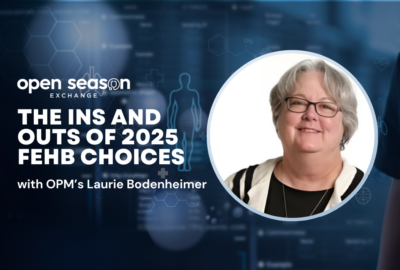2025 Open Season Exchange: OPM’s Laurie Bodenheimer on what PSHB enrollees can expect
For the PSHB’s inaugural Open Season, OPM expects a number of incoming questions from Postal employees and annuitants as they review their health care options...
About three years in the making, the Office of Personnel Management is officially launching the Postal Service Health Benefits Program for Postal Service employees, annuitants and their family members.
For PSHB’s inaugural Open Season, OPM is expecting a number of questions to come as employees and annuitants review their health care options for the coming plan year.
“We’re very excited about how far we’ve come and what we hope to offer Postal enrollees as we move forward,” Laurie Bodenheimer, OPM’s associate director for healthcare and insurance, said during Federal News Network’s 2025 Open Season Exchange. “But we know this is a big change for them, and we are working hard to make it as seamless as possible, and to offer very comprehensive customer support as we go through this transition.”
To try to make the transition into PSHB as easy as possible, OPM is automatically enrolling all participants into a PSHB plan comparable to what they had in the Federal Employees Health Benefits Program. More than 90% of participants will be enrolled in an entirely comparable Postal plan.
Those who are interested in adjusting or reviewing their enrollments can do so during Open Season.
“Our overriding goal in implementing this program is to make sure everybody who had coverage continues to have coverage, so we can feel comfortable that that they are enrolled in a plan,” Bodenheimer said.
During the planning process, OPM aimed to bring in a number of carriers with plans just as comprehensive as what participants were accustomed to in FEHB, Bodenheimer said. For plan year 2025, the new PSHB Program has 69 plan options offered across 30 health carriers, which includes seven fee-for-service carriers and 23 health maintenance organizations.
PSHB’s benefits and cost sharing are also identical to FEHB, although the premiums are slightly different. For 2025, PSHB enrollees premiums are rising by an average of 11.1%, compared with an average 13.5% increase coming for FEHB participants.
There is also a new plan comparison tool for PSHB enrollees, called the “decision support tool,” which is entirely separate from the FEHB plan comparison tool. Using the tool, PSHB enrollees can compare up to three plans at a time to see which providers are in network and compare out-of-pocket costs. The resource is available for participants to use on the PSHB’s central enrollment platform.
PSHB participants can also find more information on their plan options, Medicare, automatic enrollments and much more on OPM’s website.
How Medicare will work in the Postal program
Although the two health insurance programs are similar, one significant difference between FEHB and PSHB is how each program operates in tandem with Medicare.
Like FEHB, PSHB requires carriers to integrate a Medicare Part D Employer Group Waiver Plan into their benefits. Anyone who is eligible for Medicare will be automatically enrolled into a Part D EGWP during Open Season.
PSHB participants can choose to opt out of Part D coverage, but that’s where the crucial difference comes in.
“If you do opt out of that Part D coverage, you will not have prescription drug coverage under your PSHB plan. There are undoubtedly very few people for whom that is the right choice,” Bodenheimer said. “We strongly encourage you to ask a lot of questions and make sure that’s the right decision for you.”
OPM’s decision to implement the difference in Medicare coverage, by removing underlying prescription drug coverage for PSHB enrollees who opt out of Part D, is based on the language of the Postal Service Reform Act.
“We’ve issued several regulations to explain some of the decisions that we’ve made and how those will be implemented,” Bodenheimer said. “We will continue to put out more guidance to carriers and to the agencies that are most impacted … to make sure that everyone is fully aware of their obligations and how this program will operate.”
Combating confusion in PSHB’s inaugural Open Season
OPM is anticipating some level of confusion from PSHB annuitants during this initial Open Season about the ins and outs of Medicare and how it will all work in the new insurance program.
“Sometimes an enrollee makes a decision based on bad information or not understanding the whole picture,” Bodenheimer said. “We wanted to try to ameliorate that to the greatest extent possible.”
According to OPM’s final rule on PSHB, Postal annuitants who opt out of Part D due to an “error” can contact their carrier and request to opt back in. OPM said it plans to use the flexibility broadly — at least for the first plan year, if not for the first several years of the PSHB program.
“We’re working with the carriers on how to help enrollees in those situations,” Bodenheimer said.
Earlier this year, OPM also held a special enrollment period for current postal annuitants who were not yet enrolled in Medicare Part B. During the period, annuitants could enroll in the program with USPS picking up the cost of any late enrollment penalties. About 40,000 annuitants chose to sign up for Medicare Part B during the special enrollment period.
Throughout this year’s Open Season, Bodenheimer said OPM is standing at the ready to help Postal participants and answer any questions they may have.
“Any new program can be challenging to implement, but for this change in particular, we have spent quite a bit of time on our customer support ecosystem. We are working with several different customer support organizations and are trying our best to make sure it’s a seamless experience for customers,” Bodenheimer said. “This will be a very different Open Season for all of us in terms of trying to make sure that our customers are well supported, well cared for, and that their questions are answered as we move into this Jan. 1 implementation date.”
Discover more articles and videos now on Federal News Network’s 2025 Open Season Exchange event page.
Copyright © 2024 Federal News Network. All rights reserved. This website is not intended for users located within the European Economic Area.
Drew Friedman is a workforce, pay and benefits reporter for Federal News Network.
Follow @dfriedmanWFED






